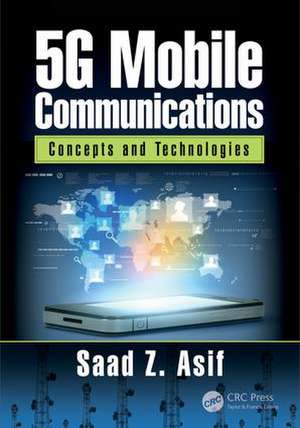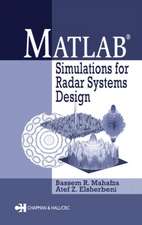5G Mobile Communications: Concepts and Technologies
Autor Saad Asifen Limba Engleză Hardback – 4 sep 2018
The readers will find a considerable amount of information on 4G (LTE-Advanced), LTE-Advance Pro, 5G NR (New Radio); transport network technologies, 5G NGC (Next Generation Core), OSS (Operations Support Systems), network deployment and end-to-end 5G network architecture.
Some details on multiple network elements (end products) such as 5G base station/small cells and the role of semiconductors in telecommunication are also provided. Keeping trends in mind, service delivery mechanisms along with state-of-the-art services such as MFS (mobile financial services), mHealth (mobile health) and IoT (Internet-of-Things) are covered at length. At the end, telecom sector's burning challenges and best practices are explained which may be looked into for today's and tomorrow's networks.
The book concludes with certain high level suggestions for the growth of telecommunication, particularly on the importance of basic research, departure from ten-year evolution cycle and having a 20-30 year plan.
- Explains the conceivable six phases of mobile telecommunication's ecosystem that includes R&D, standardization, product/network/device & application development, and burning challenges and best practices
- Provides an overview of research and standardization on 5G
- Discusses solutions to address 5G spectrum requirements while describing the global frequency spectrum allocation process
- Presents various case studies and policies
- Provides details on multiple network elements and the role of semiconductors in telecommunication
- Presents service delivery mechanisms with special focus on IoT
Preț: 1353.64 lei
Preț vechi: 1692.04 lei
-20% Nou
259.10€ • 281.54$ • 217.79£
Carte tipărită la comandă
Livrare economică 21 aprilie-05 mai
Specificații
ISBN-10: 1498751555
Pagini: 354
Ilustrații: 42 Tables, black and white; 3 Illustrations, color; 137 Illustrations, black and white
Dimensiuni: 178 x 254 x 21 mm
Greutate: 1.11 kg
Ediția:1
Editura: CRC Press
Colecția CRC Press
Public țintă
AcademicCuprins
Notă biografică
Asif is a strategic thinker, researcher, and telecommunications policy expert. He has been at the forefront of technology research and standardization and in providing strategic guidance throughout his career. He has led one of the first teams across the globe to evaluate state-of-the-art technologies such as 3G, 4G, Smart Antennas, e-band microwave radios, dense wavelength division multiplexing (DWDM), and many more. He played a key role in designing Sprint’s wireless high-speed data strategy, Jazz’s Broadband strategy, and Telenor’s Pakistan’s 3G and Transmission Network strategies.
He is one of the main authors of GSMA’s (Global System for Mobile Association) award winning Pakistan’s National Telecommunications Policy 2015. He was also one of the key players in the successful execution of two frequency spectrum auctions that generated more than US$700 million for the national exchequer. He was also instrumental in defending the country’s scarce resource (frequency spectrum) at the World Radiocommunication Conference 2015. He has produced a Policy Directive on 5G and developed Pakistan’s first 3-year rolling Frequency Spectrum strategy and Cyber Governance policy.
Asif has written two books and numerous peer-reviewed technical papers on telecommunications. He has been granted five patents as a co-patentee by the United States Patent & Trade Office. He has also been listed as a scientist in the Productive Scientists of Pakistan directory since 2009. He has also been a senior member of the IEEE (Institute of Electrical and Electronics Engineers) since 2004. He also served on the board of directors of Pakistan’s National Radio & Telecommunication Corporation.
Asif earned a BS and an MS in electrical engineering from Oklahoma State University in 1996 and 1997, respectively. He also earned an MS in engineering management from the University of Kansas in 2001.
Recenzii
Matt Walker, Chief Analyst, MTN Consulting LLC
"This [book is] a perfect resource for both beginners and experts."
~Dr. Sabit Ekin, Oklahoma State University
"This book will be a good addition to knowledge, because its provides the basic concepts of 5G communication and also discuss all the underlying technologies used for communication."
~Ghulam M. Chaudhry, Ph.D., University of Missouri-Kansas City
"The main strength, in my view, is that the Author has spent several years in the field, working for Telecom Operators and Policy making bodies. His practical hands-on experience and real-life problems that he faced and how he solved them adds real value and is the main strength of this book.
I like the approach taken by the Author to gradually build the background, present the big picture first before divulging in to details. For example, he starts with with concept of basic and applied research and how its applicable in telecommunications; the need of standardization and the role standardization bodies; product development; end-to-end architecture of a mobile network; and key challenges as well as best practices in telecom industry.
….it is a very unique book in which the Author has not only covered almost all the technical aspects of 5G Technology but also walked the reader through the journey which lead up to this development. He has provided the big picture of why and how technological developments materialize. From conception of idea to commercial deployment of technologies, the Author has beautifully captured the phases involved."
~Imad Memon, Pakistan Telecommunications Authority
Descriere
This book will help readers comprehend technical and policy elements of telecommunication particularly in the context of 5G. It first presents an overview of the current research and standardization practices and lays down the global frequency spectrum allocation process. It further lists solutions to accommodate 5G spectrum requirements.
The readers will find a considerable amount of information on 4G (LTE-Advanced), LTE-Advance Pro, 5G NR (New Radio); transport network technologies, 5G NGC (Next Generation Core), OSS (Operations Support Systems), network deployment and end-to-end 5G network architecture.
Some details on multiple network elements (end products) such as 5G base station/small cells and the role of semiconductors in telecommunication are also provided. Keeping trends in mind, service delivery mechanisms along with state-of-the-art services such as MFS (mobile financial services), mHealth (mobile health) and IoT (Internet-of-Things) are covered at length. At the end, telecom sector's burning challenges and best practices are explained which may be looked into for today's and tomorrow's networks.
The book concludes with certain high level suggestions for the growth of telecommunication, particularly on the importance of basic research, departure from ten-year evolution cycle and having a 20-30 year plan.
- Explains the conceivable six phases of mobile telecommunication's ecosystem that includes R&D, standardization, product/network/device & application development, and burning challenges and best practices
- Provides an overview of research and standardization on 5G
- Discusses solutions to address 5G spectrum requirements while describing the global frequency spectrum allocation process
- Presents various case studies and policies
- Provides details on multiple network elements and the role of semiconductors in telecommunication
- Presents service delivery mechanisms with special focus on IoT




















